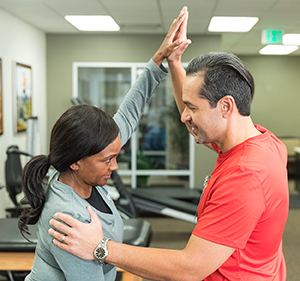Physical Problems After Brain Injury
Physical Problems After Brain Injury
Injury to the brain can affect other parts of the body. As a result, people who have a brain injury may have little or no control over their bodies. Muscles may weaken, tighten, or twitch. People may develop sensory problems, problems speaking, trouble with hand-eye coordination, and other problems. Some people may also have physical injuries that occurred along with the brain injury.
Improve posture and motion
Physical therapists help people regain movement and strength. Improving posture and range-of-motion exercises improve movement. In addition, they help prepare people to do tasks. For instance, a person may work on lifting an arm above the head. This may help him or her dress more easily.
You can help by doing the following:
Show interest. Ask the therapist how you can help.
Remind the person to use good posture.
Make sure an affected arm or leg is supported in the proper position.
Reduce swallowing problems
If a person has trouble swallowing, a speech therapist may help him or her increase muscle control in the face, mouth, and throat. The person may also learn to turn or hold the head in a position that makes swallowing easier and safer.
You can help by doing the following:
Check with a team member before bringing in food or drink. If the person has a swallowing problem, he or she may be on a special diet.
Limit distractions during meals.
Take smaller bites or sips.
Change the texture of food such as softening, chopping, or pureeing solid foods for easier swallowing.
Eat while sitting up only.
Reduce muscle and joint problems
Damage to the brain may tighten muscles or tendons (contracture). Sometimes an injury causes spasms that jerk or twist affected muscles (spasticity). Range-of-motion or stretching exercises may help control these problems. Sometimes casts or splints are used to hold a joint in proper position. Over time, this may relax the muscle. Sometimes surgery is needed to release tight tissue. Medicines to help relax the muscles may be helpful for spasticity.
You can help by doing the following:
Make sure your loved one does any prescribed exercises or stretches daily.
Be sure the splint is on when it needs to be.
Control seizures
If too many signals flood the brain, a seizure may occur. Medicines may control these episodes. Keep in mind that if a person has multiple, unprovoked seizures, he or she should be evaluated for epilepsy.
You can help by doing the following during a seizure:
Help the person into a safe position. Make sure your loved one will not fall or hit his or her head.
If they are lying down, turn them to the side with mouth pointed down.
Don't restrain the person or put anything in his or her mouth.
Tell a team or staff member.
Call for emergency help if a seizure lasts more than 5 minutes.
Updated:
February 27, 2018
Reviewed By:
Images Reviewed by Staywell medical art team.,Sather, Rita, RN,Shelat, Amit, MD
